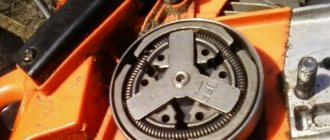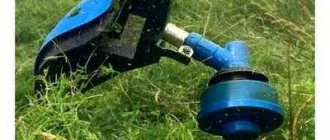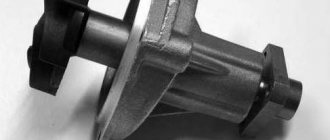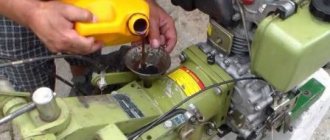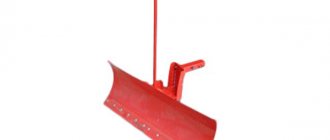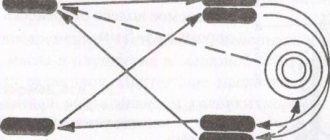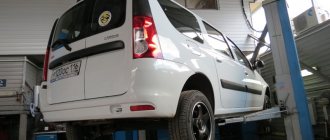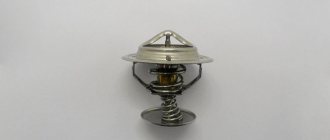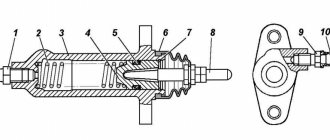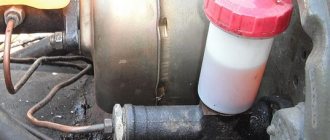According to the instructions that come with the car, Matiz antifreeze should be replaced every 40,000 kilometers or two years of operation. Never be late with a replacement, and in our conditions it is advisable to carry it out even earlier. The replacement process itself is quite simple and even a novice car enthusiast can do it.
Coolant for a car consists of several components:
- water;
- antifreeze;
- additives that are necessary to prevent rust in the cooling system and engine, in addition, they prevent destructive processes directly in the coolant.
We carry out the replacement ourselves
All work on changing the coolant should be carried out only when the engine has completely cooled down. Otherwise, you risk getting burned. Before starting work, the car must be placed on a horizontal, flat surface.
What antifreeze should I use?
Concentrated Liqui Moly KFS 2000
At specialized service stations, Liqui Moly KFS 2000 is poured to cool Daewoo Matiz car engines. It is a blue liquid based on ethylene glycol and a set of additives that successfully prevent the appearance of corrosion, foam and other negative processes. You can also use a domestic product, for example, from Lukoil.
Coolant replacement kit: Lukoil antifreeze, distilled water, flushing
To cool the Daewoo Matiz engine, you can only fill it with ethylene glycol-based coolant!
Tools
- ten liters of distillate;
- a set of keys;
- screwdrivers;
- two liters of concentrated antifreeze.
- pliers;
- capacity of five liters;
- rags.
Replacement instructions
- First you need to remove the air filter along with the housing. To do this, slightly unscrew the bolt that tightens the clamp on the pipe, then unscrew the bolts securing the housing and remove the sensor connector.
Remove the air filter along with the housing - Using pliers, we squeeze the antennae of the clamp of the lower radiator pipe and move it down. Place a pre-prepared container under the pipe and remove the hose.
The antennae of the clamp need to be compressed - To depressurize the cooling system, you need to remove the filler cap from the expansion tank.
Unscrew the tank cap - Unscrew the top bolts securing the radiator. Remove the pipes located at the top of the radiator. We directly remove the radiator itself and rinse it with distillate.
Removing the heat exchanger - Using pliers, we squeeze the three clamps on the hoses that go to the tank in turn. Having disconnected the hoses and fastening, remove and rinse the tank with distillate.
Removing the tank - We return it clean to its place. We connect the hoses.
We return it to its place - We install the radiator in its place and connect the pipe to it. Then we put back the air filter with the housing. We connect the sensor and air duct.
- We fill the distillate; when pouring, we hold the canister with one hand, and with the other, to prevent air plugs from forming, we squeeze the pipe.
- We start the engine for about fifteen minutes, in the meantime, dilute the concentrated antifreeze with distillate in equal proportions and, after tightening the cap, mix thoroughly.
Dilution kit - We turn off the engine and wait for it to cool down. Drain the distillate from the system. We connect the pipes to the tank and radiator.
- Pour the resulting coolant into the reservoir. Be sure to squeeze the lower radiator hose. You need to pour to the maximum level, and then tighten the cap on the tank tightly. Fill in the coolant
- We start the engine and let it run for fifteen minutes. Checking the level in the tank. Filled with liquid
Loading …
Video “Replacing coolant on a Daewoo”
The process of replacing antifreeze in many cars is very similar, in particular to Daewoo Sens and Daewoo Matiz. After looking at how to change the coolant on a Daewoo Sens, you can easily replace it with a Daewoo Matiz.
Was this article helpful?This article was helpfulPlease share the information with your friends
Leaks and problems
With a normal level of maintenance, global problems do not arise in the cooling system of this vehicle. Of course, over time, the thermostat and pump wear out, but this concerns more of their service life.
But leaks most often occur due to failure to follow recommendations. For example, it is recommended to change the expansion tank cap when replacing the coolant. Since the valve located in it may become sour.
Most often, this leads to an increase in pressure in the system and, as a result, a leak. Moreover, a leak can occur in any weak spot. Therefore, it is better to follow the recommendations to avoid problems in the future.
How to change antifreeze on Daewoo Matiz
The compact car Daewoo Matiz is a representative of the budget segment. Therefore, car enthusiasts prefer to do many maintenance jobs with their own hands. Replacing antifreeze is also a simple operation if you follow the instructions.
Stages of replacing Daewoo Matiz coolant
In the cooling system of the Daewoo Matiz, sediment and plaque often form. Therefore, when replacing antifreeze, it is recommended to flush the entire system. This will clear deposits and restore normal heat exchange.
The cars on the market are equipped with 0.8 liter and 1.0 liter petrol engines. This also applies to older models, as well as those that have undergone restyling. Therefore, the replacement process in them will be similar.
Coolant drain
Any flat surface is suitable for draining antifreeze from the Daewoo Matiz; you can combine the replacement with a trip to the country. Therefore, we place the car on a suitable flat area, wait until the engine cools down a little and proceed to action:
- Open the hood and remove the air filter along with the housing (Fig. 1). To do this, unscrew the 3 10mm head bolts. Loosen the air duct corrugation clamp and disconnect the mass air flow sensor connector.
Fig.1 Air filter housing
- At the bottom of the radiator on the passenger side we find a pipe, place a container under it to collect the old coolant. We compress the clamp on the pipe and move it down, after which the hose can be removed (Fig. 2).
Fig.2 Lower radiator pipe
- To speed up the draining process, unscrew the cap on the filler neck of the expansion tank (Fig. 3).
Fig.3 Tank cover
- The liquid will not completely drain from the radiator, so we will have to remove it. To do this, you need to unscrew the 2 10mm head bolts from above. Remove the fan power supply, as well as the 2 hoses on top. Thick for circulation and thin for steam removal going to the expansion tank. After this, we take out the radiator along with the fan and drain the remaining liquid (Fig. 4).
Fig.4 Radiator with fan
This method produces the most complete drainage of antifreeze. Despite the seemingly complex process, there should not be any particular difficulties. All elements have free access, and a big plus is the ability to perform the operation on any flat surface.
Flushing the cooling system
Since we have removed the radiator, we can inspect it for surface contamination and, if necessary, wash it. Also, for washing, you can remove the expansion tank, which is simply attached to the guides.
Before the main flushing, we put everything in its place, connect the removed hoses and wire connectors. In case of severe contamination, we use special washes from well-known manufacturers.
It is recommended to pay attention to flushing products from LAVR or HiGear; according to user reviews, they are of the highest quality. Instructions and method of use for each of them are printed on the back of the package.
After such washing, the system should be flushed with distilled water. It is recommended to do 2-3 runs with a complete drain. The washing stage itself is as follows:
- Water is poured into the expansion tank according to the level.
- The tank cap is screwed on and the engine starts.
- We wait until it warms up completely, after which we drain.
Using this method, the cooling system of the Daewoo Matiz will be completely flushed and prepared for the addition of new antifreeze.
Filling without air pockets
The cooling system on a Daewoo Matiz car is designed in such a way that the return flow passes through the expansion tank. Therefore, even if an air lock forms, it will still come out during circulation.
This simplifies the task by not having to resort to unnecessary actions. Just pour new antifreeze into the expansion tank to the level and warm up the engine. After warming up and subsequent cooling, check the level again and top up if necessary.
The replacement is completed, as we see, the operation is not difficult and if you follow it strictly according to the instructions, then everyone can handle it. The main thing is not to forget to put back all the disconnected parts, and also drain the engine when it has cooled down.
Replacement frequency, what antifreeze to fill
When performing vehicle maintenance work, it is recommended to adhere to the manufacturer’s instructions for performing a particular operation. So, for Daewoo Matiz, the scheduled period for replacing antifreeze is 4 years or 80,000 kilometers.
Regarding the antifreeze to be poured, the manufacturer does not give us specific recommendations. It only indicates that the coolant used should be ethylene glycol based.
Therefore, the choice remains with the user whether to use G11 or G12. But we can add on our own that G12 antifreezes are produced using more modern technology.
They also have improved anti-corrosion protection.
Among the brands present on the market, it is worth paying attention to AGA or Felix, which has proven itself well among users. GreenCool, created using German technology but produced in Belarus, also has good reviews.
How much antifreeze is in the cooling system, volume table
Leaks and problems
With a normal level of maintenance, global problems do not arise in the cooling system of this vehicle. Of course, over time, the thermostat and pump wear out, but this concerns more of their service life.
But leaks most often occur due to failure to follow recommendations. For example, it is recommended to change the expansion tank cap when replacing the coolant. Since the valve located in it may become sour.
Most often, this leads to an increase in pressure in the system and, as a result, a leak. Moreover, a leak can occur in any weak spot. Therefore, it is better to follow the recommendations to avoid problems in the future.
Video
Obvious breakdowns due to which antifreeze runs out
Most often, antifreeze quickly disappears from the expansion tank if one of the following malfunctions is present.
Radiator defect or damage. The malfunction can be easily determined by smudges under the car. You can also look under the bottom - drops of the color of your antifreeze will probably be visible there. The main reason for radiator failure is failure of the tightness of thin tubes called honeycombs. Such malfunctions are most often caused by damage, for example, a stone falling from under the wheels of another car.
In old cars that have been in use for more than 10 years, rust often forms on the radiator tubes. Corrosion destroys the tubes completely. For the same reasons, the side plastic expansion tank may lose its seal.
Damage to the interior heating radiator. With such a malfunction, antifreeze will leave the system as quickly as with a leaky main radiator. But determining the cause will be much more difficult. A situation often occurs when the coolant leaves the expansion tank, but the leak cannot be found. In this case, the problem is usually a damaged heater radiator. The antifreeze then leaks onto the interior seal. The advice of experienced motorists is to pay attention to detail - a specific smell may arise in the cabin.
Regular fogging of the windows, regardless of the weather, can also be evidence of a leaking heater core. But to be 100% sure that the problem is in the stove, you need to remove the dashboard. If it is not possible to carry out such repairs yourself, it is better to contact professionals at a service station.
The most common problems with the cooling system are a malfunction of the expansion tank or its cap. Therefore, if the antifreeze runs out, it is advisable to inspect these parts first. It is not difficult to detect a leaky cap or a cracked expansion tank even with a simple inspection. This will be indirectly indicated by traces of antifreeze leakage and splashes on other components under the hood.
It is difficult to detect damage to the lower part of the expansion tank. On most vehicles this will require removing it completely. If damage cannot be detected, then there is no need to replace parts.
This means that you should pay attention to the bypass valve built into the tank plug. This unit is subject to frequent blockages, due to which antifreeze escapes through the expansion tank
The cooling system contains connecting hoses. Exposure to hot antifreeze causes them to expand, and subsequent cooling of the car causes them to return to their original size. In winter, hoses become narrower due to exposure to low temperatures. As a result, the amount of liquid in the expansion tank varies.
We recommend
“Is it possible to add antifreeze or dilute it with water?” Read more Destruction of metal tubes. Despite their strength and durability, sooner or later metal tubes are destroyed. Most often, resource depletion is to blame. Foci of emerging corrosion are not always noticed in time, and through cracks form very quickly. Coolant escapes through these leaks at high speed.
Pump and thermostat malfunctions. These units are needed to pump and control coolant flows. The body material of these mechanisms - plastic or metal - varies depending on the year of manufacture and model of the car. Successful repair of the pump and thermostat is unlikely; it is often recommended to replace them with new ones.
Pump leakage. If a puddle appears under the car just under the water pump, then there is a high probability that the problem is with the pump. However, determining exactly where the liquid goes is quite problematic. It's all about the multitude of casings, protections, boots, seals and other elements that can collect leaking liquid.
The pump as a mechanism is very strong and intact, but leakage most often occurs through the oil seal or gasket between the cylinder block and the pump flange. In this case, a front-wheel drive car is more labor-intensive to diagnose, since this pump is most often structurally located under the timing cover.
Replacing antifreeze on Daewoo Matiz
Replacing antifreeze on a Daewoo Matiz is not difficult, however, taking into account the specifics of the assembly, it has certain differences from the general procedure. The car owner can carry out the entire procedure independently if he has technical skills and knowledge.
Antifreeze replacement interval
Antifreeze in Daewoo Matiz is replaced every 4 years or after a mileage of 80 thousand km. The values are basic and imply the absence of other factors affecting the efficiency of the coolant.
If the antifreeze has become discolored or has acquired a brown, reddish or black tint, it should be replaced as soon as possible. A change in color indicates poor quality of the product, lack of necessary additives and the negative impact of the coolant on the entire system.
To avoid failure of more expensive components, antifreeze should be purchased from trusted official dealers. Experts pay attention to the following brands suitable for Daewoo Matiz:
- 1998-2002 year of manufacture - antifreeze category G12, MOTUL Ultra, Castrol LF, GlasElf, AWM, Lukoil Ultra are suitable;
- 2003-09 - G12+, Lukoil Ultra, G-Energy, Havoline, AWM, Freecor are suitable;
- Daewoo Matiz cars since 2010 require category G12++; antifreeze Glysantin G 40, Freecor DSC, VAG, Frostschutzmittel A is suitable.
The amount of coolant depends on the engine size: 0.8 liters will require 3.8 liters of antifreeze, and a one-liter engine will require 4.2 liters. If a concentrate is purchased, the volume is calculated taking into account the addition of distilled water.
How to properly check the level in Daewoo Matiz?
The coolant level is checked in the expansion tank under the hood of the car. The MAX mark is tinted black, the MIN mark is the weld seam of the expansion tank itself.
To check the antifreeze level, no additional manipulations are required; the translucent body allows you to estimate the volume without unscrewing the cap. However, in addition to the amount of coolant, its color is also monitored, as well as the presence of sediment, foam, dirt and other factors indicating the need to replace antifreeze with Daewoo Matiz.
To properly check the level and condition of antifreeze, turn off the car engine and allow it to cool. Experts note that the coolant, especially when the engine has recently been running, is under pressure. Opening the lid suddenly may cause toxic liquid to splash and get on your hands and face.
Open the cover carefully, only when the engine is cool and, if possible, wearing gloves. Some experts also recommend removing the negative lead from the battery as an additional precaution.
How to make a replacement?
Replacing antifreeze in Daewoo Matiz is carried out taking into account three main stages of the process - draining the old coolant, flushing the system and filling in a new solution.
Pay special attention to the need for washing. After draining, a certain amount of old coolant remains in the system. If it turns out to be of poor quality or the car owner purchased a different brand of antifreeze, the residue should be thoroughly rinsed.
When flushing the Daewoo Matiz cooling system, it is not recommended to use special flushing fluids. In the absence of drain taps, such mixtures will also settle in the system, which will require additional cleaning procedures. Taking this factor into account, the old antifreeze is washed out with distilled water.
Preparation
To replace antifreeze in Daewoo Matiz you will need the following equipment :
- pliers, wrenches and screwdrivers for removing fasteners, pliers;
- gloves, a clean rag, a funnel for pouring;
- a container for draining waste liquid and rinsing water; usually a basin and additional containers with a volume of 5 liters or more are used;
- consumables - new antifreeze, distilled water from 10 liters for mixing with concentrate and flushing the system.
The car is parked on level ground. The presence of a pit is not necessary, especially if a basin is intended to be used. When preparing, take into account the toxicity of antifreeze and take measures to ensure that there are no animals or children nearby, and to ensure that the liquid does not get into the soil when drained.
The question of how to drain antifreeze from a Daewoo Matiz is resolved by a general procedure. However, the specifics of the assembly of this model require additional operations.
Step-by-step instruction
The step-by-step process of replacing antifreeze with a Daewoo Matiz involves the following procedure:
- the engine is allowed to cool, as an additional precaution, the minus is removed from the battery, and then it is returned when warmed up and when work is completed;
- dismantle the air filter and housing - to do this, loosen the clamp on the pipe and unscrew the bolts holding the housing, and also remove the connector from the sensor;
- on the pipe at the bottom of the radiator, compress the tendrils of the clamp, place a container for drainage and remove the hose;
- at the outlet of the expansion tank, unscrew the plug, which ensures depressurization and faster drainage;
- remove the radiator - to do this, unscrew the fasteners holding it and remove the pipe from the top;
- replacing antifreeze on a Daewoo Matiz without removing the radiator is allowed, however, given the lack of drain valves, it requires additional flushing procedures and does not guarantee complete release of the system from waste coolant;
- the removed radiator is washed with distilled water;
- remove the expansion tank, which is also washed separately;
- the expansion tank and radiator are returned to their place, connecting and tightly fitting all existing connections;
- the air filter is returned to its place, the system is restored to its original form, after which distilled water is poured into the filler neck;
- start the engine and let it run for 15-20 minutes, then turn it off and let it cool;
- the air filter is removed again, distilled water is drained from the system, after washing the radiator and expansion tank it should be relatively clean;
- Having restored the system again, new antifreeze is poured into the expansion tank, periodically squeezing the lower radiator hose to avoid the formation of air locks;
- Coolant is poured to the MAX level, the plug is tightened, and the engine is warmed up for 15 minutes.
If after running the engine the antifreeze level has dropped, add it to the upper limit. A few days after replacement, the level and color of the fluid are checked, if necessary, it is topped up or replaced with a new one. A constant drop in the coolant level indicates leaks - the connections are loose or there are components that require replacement.
Replacing antifreeze on Daewoo Matiz / Daewoo Matiz
If you decide to replace antifreeze in Matiz on your own , then these instructions will help you.
There shouldn’t be any particular difficulties; everything is quite simple. These recommendations are suitable for replacing coolant in Renault Logan. So, to carry out the work you will need the following:
- Two five-liter canisters with distilled water.
- Antifreeze concentrate in the amount of 2 liters. Use coolant that is suitable for your vehicle. For Matiz, the use of high-class antifreeze is acceptable. These are G11, G12, G13, which can be produced both at foreign and domestic factories.
- Tools: Phillips and flathead screwdriver, 10mm wrench, pliers.
Do-it-yourself replacement of coolant on a Daewoo Matiz
For Matiz, it is not necessary to look for an inspection hole or overpass; a flat area will be enough. We are waiting for the engine to cool down so as not to get thermal burns.
First you need to pull out the air filter housing. Unscrew the three bolts, squeeze the clamp with pliers and slide the filter down the radiator pipe. Now carefully remove the pipe itself, a little antifreeze will flow out of it, this is normal.
Prepare an empty container with a minimum volume of 4 liters and unscrew the cap of the expansion tank. Drain the used fluid.
Our next action will be to remove the radiator along with the fan, which is secured with bolts. We free the radiator from any remaining liquid and rinse it well with water. Take pliers and remove the expansion tank. Also rinse it with water.
Place the expansion tank and radiator in their places. Check how securely the filter housing is attached to the radiator (remember the sensor connectors) and the removed pipes. Now pour distilled water (4 liters) into the tank, while kneading the lower pipe with your hand. Close the expansion tank with a lid and start the car.
We will flush the cooling system for approximately 15 minutes. By the way, you can additionally use special cleaning agents; they will help solve the problem of deposits in the system more effectively. They are sold in any car dealership and have detailed instructions for use.
Now prepare antifreeze. In an empty container, mix the concentrate and distilled water. The proportions are determined by the climatic conditions in which the car is operated, but the concentrate content should not exceed 70% or be less than 50% of the total composition. You will find exact instructions in the product leaflet.
Stop the engine and let it cool again. To drain the flushing fluid, you must perform the same disassembly steps described above.
Fill the prepared antifreeze to the maximum mark in the expansion tank. Pinch the lower pipe with your hand, this will reduce the number of air pockets and help the liquid to be more evenly distributed throughout the system. Close the tank lid and start the Matiz. We turn off the car and check the coolant level.
If you don't want to wait a long time for the engine to cool down, cover the lid with a thick cloth and gently open it until all the steam has escaped. Antifreeze will most likely need to be added. Check that all fastenings are secure and that there are no fluid leaks. After a few days, check the coolant level again.
The following are materials on replacing antifreeze in Nissan Almera.
